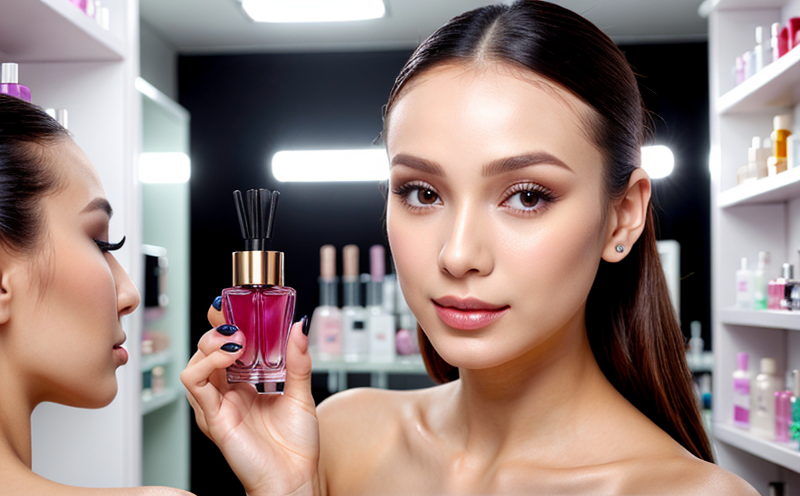Safety Testing of Perfumed Hair Products
The safety testing of perfumed hair products is a critical aspect of the cosmetic industry. Ensuring that these products are safe for consumers to use, especially when they come into direct contact with the skin and scalp, is paramount. Regulatory requirements such as those outlined in the European Union's ECR and ISO standards mandate thorough testing before any product can be marketed or sold.
The primary focus of safety testing is to identify potential allergens or irritants that could cause adverse reactions, particularly among sensitive individuals. This includes evaluating the stability of the fragrance components over time and under various environmental conditions. Additionally, testing for preservatives ensures they are effective against bacteria, fungi, and other microorganisms which can thrive in products containing water.
For perfumed hair products, the testing process involves several stages:
- Skin Irritation Testing: This involves applying a sample of the product to human skin cells or intact skin for an extended period (typically 48 hours) and observing any signs of irritation.
- Nutritional Analysis: Analyzing the nutritional content ensures that no harmful substances are present in concentrations exceeding safe limits.
- Bacteriological Testing: Checking for the presence of bacteria, fungi, or viruses to ensure product safety.
The testing procedure also includes evaluating the product's formulation under different conditions such as high and low temperatures. This helps determine whether the fragrance remains stable in a wide range of environmental conditions, which is crucial given that hair products are often used under varying climatic conditions.
Testing for allergens is another critical component because consumers may have allergies to certain ingredients commonly found in perfumed hair products like formaldehyde donors or parfum. Ensuring these are detected and quantified helps manufacturers comply with international regulations and guidelines, thereby protecting consumer health and safety.
In summary, comprehensive safety testing ensures that perfumed hair products meet stringent regulatory requirements and provide a safe user experience. By adhering to global standards such as ISO 20781:2013 (Cosmetics – General Safety Requirements) and EU regulations, manufacturers can build consumer trust and compliance confidence.
Applied Standards
The testing of perfumed hair products is governed by several international standards which provide a framework for ensuring product safety. Key among these are:
- ISO 20781:2013 – Cosmetics – General Safety Requirements: This standard outlines the general principles and requirements for cosmetic safety assessments.
- ECR (European Cosmetics Regulation): This regulation mandates testing to ensure that products are free from harmful substances such as formaldehyde donors, parfum, and other allergens.
- ASTM D7934 – Standard Practice for Evaluating the Stability of Fragrance Compounds in Cosmetic Products: Provides a method for assessing fragrance stability over time.
These standards ensure that every step of the manufacturing process adheres to best practices, thereby enhancing consumer safety and satisfaction. Compliance with these regulations is not only legally mandated but also essential for maintaining brand reputation and ensuring market access in various regions worldwide.
Benefits
- Compliance: Ensures strict adherence to international standards and local regulations.
- Consumer Trust: Builds trust by demonstrating a commitment to product safety and quality.
- Legal Protection: Reduces the risk of legal action or fines from non-compliance issues.
- Market Access: Facilitates easier entry into international markets with compliant products.
- Reputation: Enhances brand reputation by showcasing a dedication to consumer health and safety.
The benefits extend beyond mere compliance; they contribute significantly to the overall success of cosmetic brands in the global market. By prioritizing product safety, companies not only safeguard public health but also foster long-term relationships with consumers who value transparency and trust.
Customer Impact and Satisfaction
The rigorous testing process ensures that perfumed hair products are safe for use by a wide range of consumers. This translates to higher customer satisfaction as users can enjoy their products without fear of adverse reactions. For quality managers, compliance officers, and R&D engineers involved in cosmetic development, thorough safety testing is essential. It provides them with peace of mind knowing they meet stringent international standards.
From a procurement perspective, ensuring suppliers adhere to these standards minimizes risks associated with substandard or potentially harmful products reaching the market. By leveraging third-party laboratories for independent assessments, brands can further enhance their reputation and ensure consistent quality across batches.





